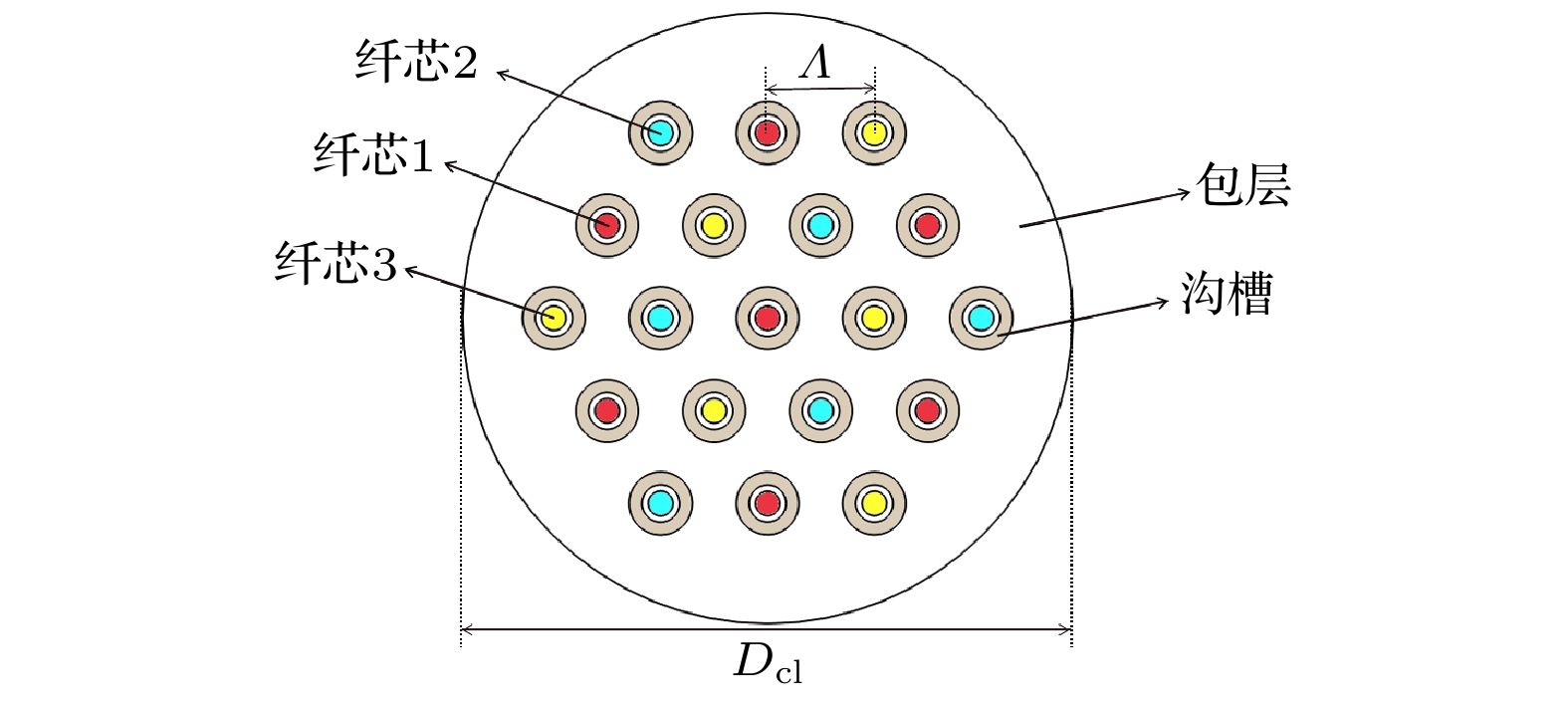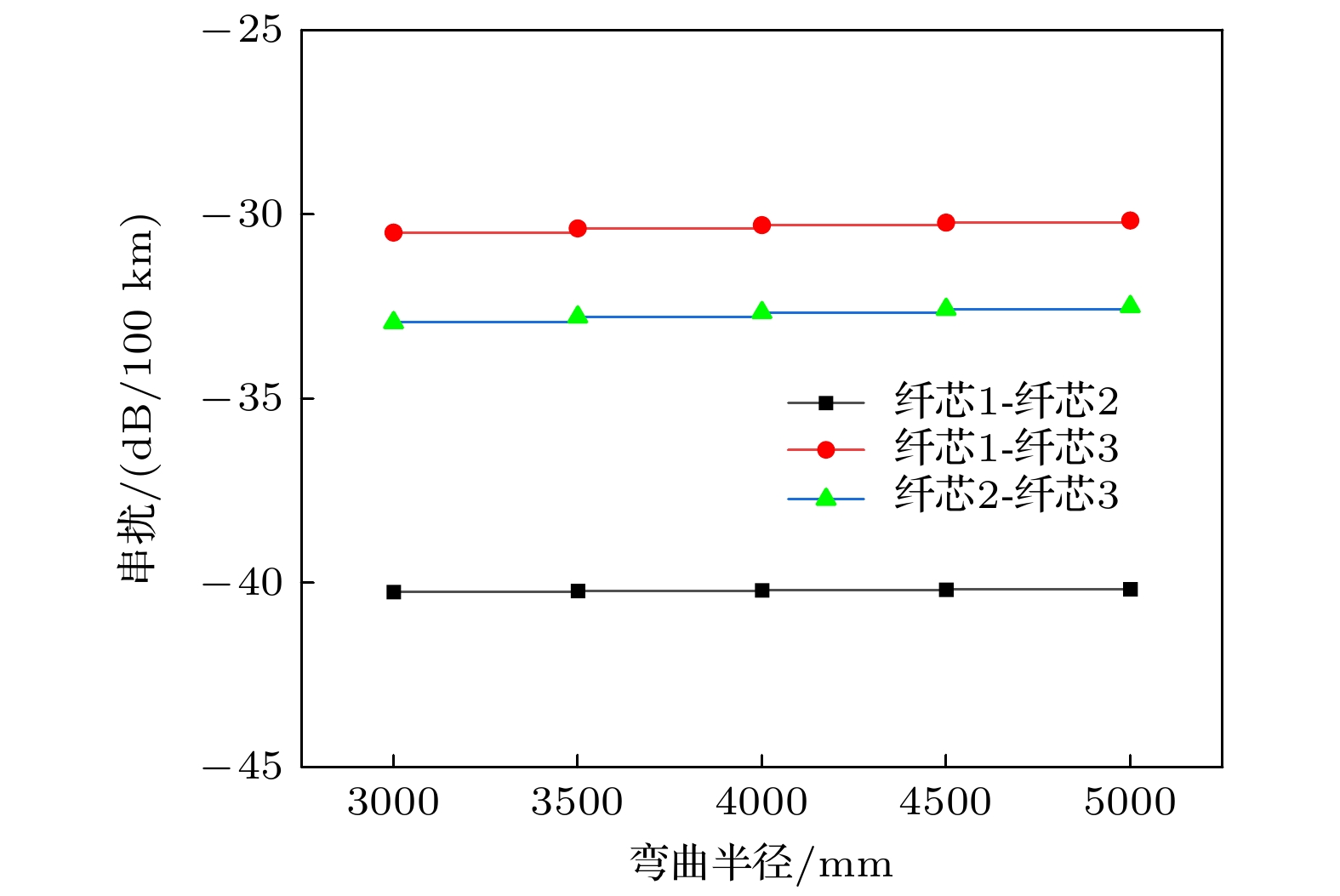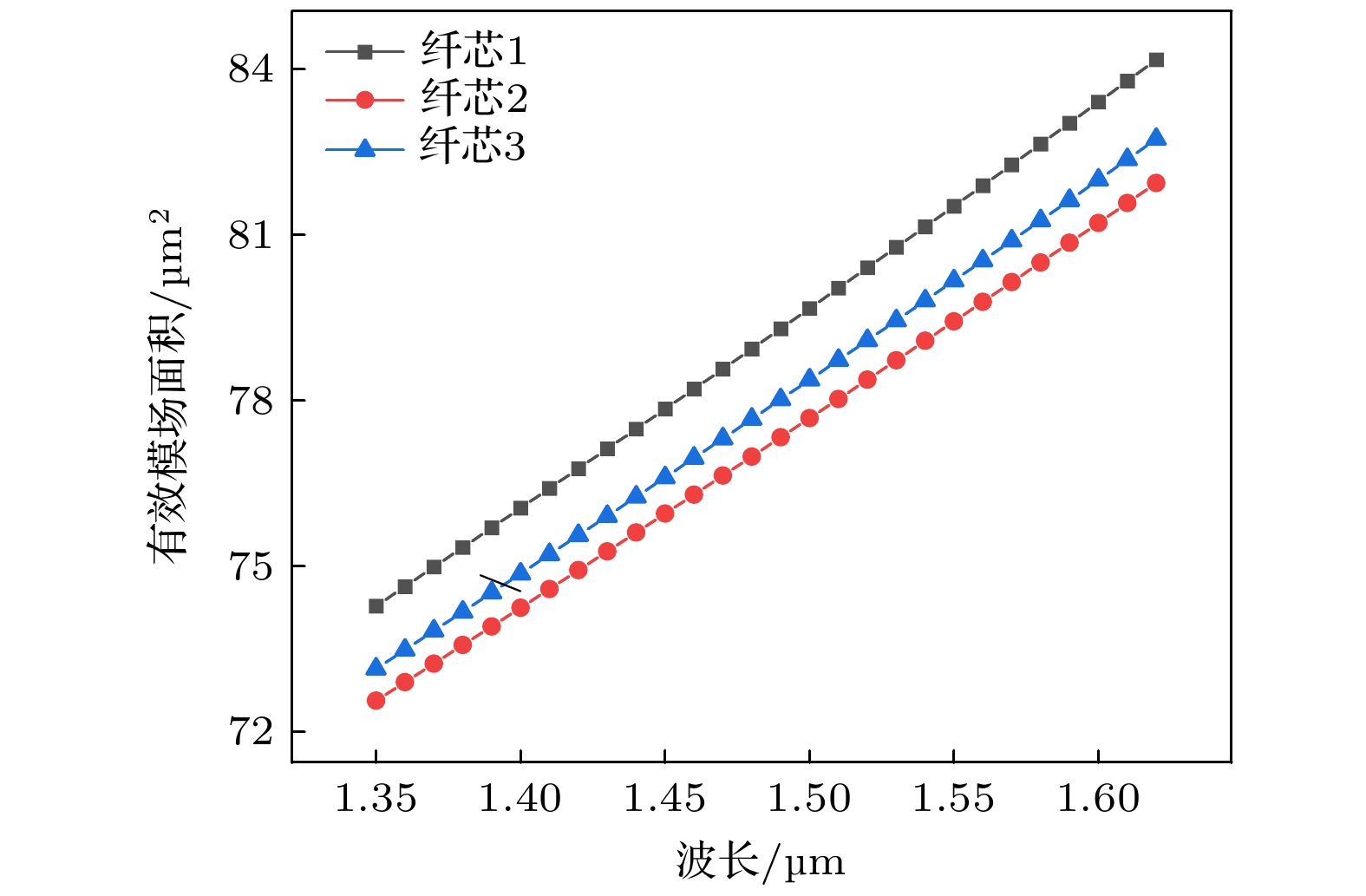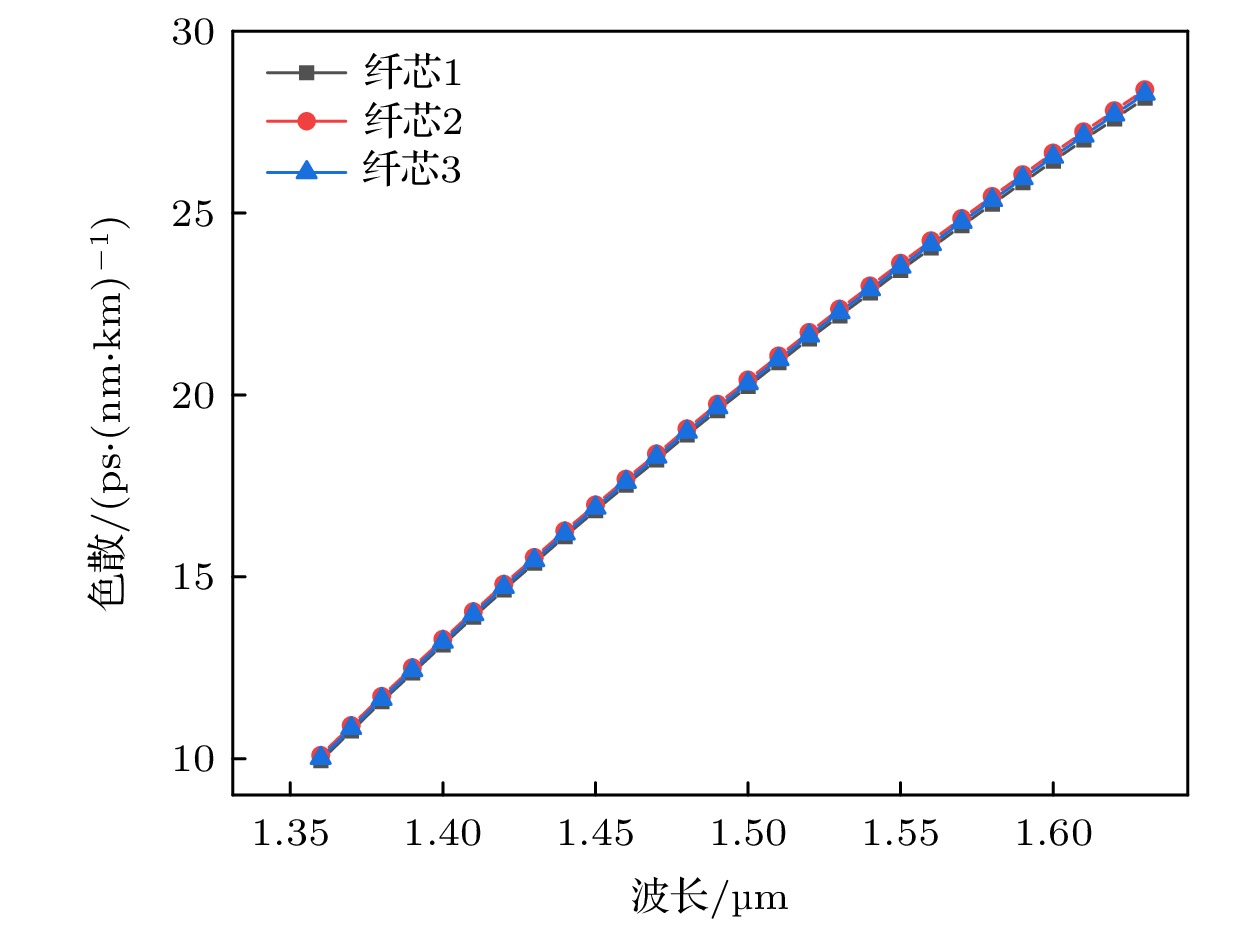-
飞速增长的光通信容量需求推动着光纤技术的发展, 基于空分复用技术的多芯光纤作为突破传统单模光纤容量限制的方法引起了广泛的关注. 本文将纤芯异质结构与低折射率沟槽结合, 设计了1种具有低串扰的十九芯单模光纤结构, 该结构由环绕沟槽的3种不同参数的纤芯按正六边形排布构成,在C+L波段能实现稳定单模传输. 研究结果表明: 在波长为1.55 μm时, 通过在沟槽中进行掺氟处理, 可以使光纤的芯间串扰降低至–39.52 dB/100 km. 此外在弯曲半径为100 mm时, 弯曲损耗为–7.7×10–5 dB/m且色散低于24 ps/(nm·km). 纤芯中基模的有效模场面积约为80 μm2, 有利于降低非线性效应. 与传统单模光纤及单沟槽同质结构光纤相比, 该结构具有更低的串扰、更好的抗弯曲性能和更大的模场面积. 本文设计的光纤适用于空分复用系统中远距离大容量的传输.The rapid growth of the demand for optical communication capacity promotes optical fiber communication technology. As a method to break through the capacity limitation of conventional single-mode fiber, multi-core fiber based on space division multiplexing technology has attracted extensive attention. In order to respond to the capacity of traditional single-mode fiber positively, we design a scheme of single-mode multi-core fiber combining the arrangement of heterogeneous fiber cores with secondary structure of low refractive index trench. The scheme consists of nineteen fiber cores arranged in a hexagonal closed-packed structure. Heterogeneous trench-assisted multi-core fiber (Hetero-TA-MCF) has low inter-core crosstalk and excellent anti-bending performance. Compared with conventional single-mode fiber, the Hetero-TA-MCF has the large transmission capacity and average effective area of each core of about 80 μm2. The transmission capacity of 19 cores is equivalent to the sum of the transmission capacities of 19 single-core single-mode fibers. We use COMSOL Multiphysics to simulate the fiber structure, finding the parameters that affect the properties of the fiber, selecting parameters and structures for optimal performance. Then we calculate the transmission characteristics by the finite element method,and the results of substantive simulating compute are as follows. The Hetero-TA-MCF achieves a low inter-core crosstalk (XT) of about –39 dB/100 km so that each core can be transmitted as a separate channe. It meets the standard of multi-core fiber long distance transmission. The XT of the heterogeneous 19-core single-mode fiber is suitable for multi-core fiber long distance transmission standards. The bending loss of the outermost fiber core is –7.7×10–5 dB/m when the bending radius is 10 cm, which reflects the low loss characteristics of the structure. The nonlinear coefficients of three kinds of core are 1.28 W–1·km–1, 1.31 W–1·km–1, and 1.30 W–1·km–1 respectively, reducing the nonlinear effect of optical fiber effectively; the dispersions of three kinds of cores are less than 24 ps/(nm·km). In addition, the steady single-mode transmission is achieved in C+L band. Compared with traditional single-mode fiber and single-trench homogeneous fiber, the proposed fiber in this work has low crosstalk, good bending resistance and large mode field area, which is suitable for long distance and large capacity transmission in space division multiplexing system.
-
Keywords:
- multi-core single-mode fiber /
- non-identical cores /
- single trench /
- low inter-core crosstalk
[1] Saitoh K, Matsuo S 2016 J. Light. Technol. 34 55
 Google Scholar
Google Scholar
[2] Cai J X, Cai Y, Davidson C R, Lucero A, Zhang H, Foursa D G, Sinkin O V, Patterson W W, Pilipetskii A, Mohs G, Bergano N S 2011 Conference on Optical Fiber Communication (OFC)/National Fiber Optic Engineers Conference(NFOEC) Los Angeles, California United States, March 6–10, 2011
[3] Richardson D J, Fini J M, Nelson L E 2013 Nat. Photonics 7 354
 Google Scholar
Google Scholar
[4] Li Z H, Wang L Y, Wang Y, Li S G, Meng X J, Guo Y, Wang G R, Zhang H, Cheng T L, Xu W W, Qin Y, Zhou H 2021 Opt. Express 29 26418
 Google Scholar
Google Scholar
[5] Sakamoto T, Saitoh K, Saitoh S, Shibahara K, Wada M, Abe Y, Urushibara A, Takenaga K, Mizuno T, Matsui T, Aikawa K, Miyamoto Y, Nakajima K 2018 J. Light. Technol. 36 1226
 Google Scholar
Google Scholar
[6] Ye F H, Tu J J, Saitoh K, Morioka T 2014 Opt. Express 22 23007
 Google Scholar
Google Scholar
[7] Takenaga K, Arakawa Y, Tanigawa S, Guan N, Matsuo S, Saitoh K, Koshiba M 2011 Conference on Optical Fiber Communication (OFC)/National Fiber Optic Engineers Conference (NFOEC) Los Angeles, California United States, March 6–10, 2011
[8] 靳文星, 任国斌, 裴丽, 姜有超, 吴越, 谌亚, 杨宇光, 任文华, 简水生 2017 物理学报 66 024210
 Google Scholar
Google Scholar
Jin W X, Ren G B, Pei L, Jiang Y C, Wu Y, Shen Y, Yang Y G, Ren W H, Jian S S 2017 Acta Phys. Sin. 66 024210
 Google Scholar
Google Scholar
[9] Xia C, Amezcua-Correa R, Bai N, Antonio-Lopez E, Arrioja D M, Schulzgen A, Richardson M, Linares J, Montero C, Mateo E, Zhou X, Li G F 2012 IEEE Photon. Technol. Lett. 24 1914
 Google Scholar
Google Scholar
[10] Egorova O N, Semjonov S L, Senatorov A K, Salganskii M Y, Koklyushkin A V, Nazarov V N, Korolev A E, Kuksenkov D V, Li M J, Dianov E M 2014 Opt. Lett. 39 2168
 Google Scholar
Google Scholar
[11] Tu J J, Saitoh K, Koshiba M, Takenaga K, Matsuo S 2013 J. Light. Technol. 31 2590
 Google Scholar
Google Scholar
[12] Tu J J, Saitoh K, Koshiba M, Takenaga K, Matsuo S 2012 Opt. Express 20 15157
 Google Scholar
Google Scholar
[13] Tu J J, Saitoh K, Takenaga K, Matsuo S 2014 Opt. Express 22 4329
 Google Scholar
Google Scholar
[14] Koshiba M, Saitoh K, Takenaga K, Matsuo S 2011 Opt. Express 19 102
 Google Scholar
Google Scholar
[15] Sakaguchi J, Puttnam B J, Klaus W, Awaji Y, Wada N, Kanno A, Kawanishi T, Imamura K, Inaba H, Mukasa K, Sugizaki R, Kobayashi T, Watanabe M 2012 Optical Fiber Communication Conference Los Angeles, California United States, March 4–8, 2012
[16] Amma Y, Sasaki Y, Takenaga K, Matsuo S, Tu J, Saitoh K, Koshiba M, Morioka T, Miyamoto Y 2015 Optical Fiber Communications Conference and Exhibition (OFC) Los Angeles, California United States, March 22–26, 2015
[17] Xie X Q, Tu J J, Zhou X, Long K P, Saitoh K 2017 Opt. Express 25 5119
 Google Scholar
Google Scholar
[18] Ademgil H, Haxha S 2012 Opt. Commun. 285 1514
 Google Scholar
Google Scholar
[19] Koshiba M, Saitoh K, Takenaga K, Matsuo S 2012 IEEE. Photon. J. 4 1987
 Google Scholar
Google Scholar
[20] Wang L Y, Li S G, Meng X J, Guo Y, Li Z H 2021 J. Opt. Soc. Am. B 38 3849
 Google Scholar
Google Scholar
[21] 李增辉, 李曙光, 李建设, 王璐瑶, 王晓凯, 王彦, 龚琳, 程同蕾 2021 物理学报 70 104208
 Google Scholar
Google Scholar
Li Z H, Li S G, Li J S, Wang L Y, Wang X K, Wang Y, Gong L, Cheng T L 2021 Acta Phys. Sin. 70 104208
 Google Scholar
Google Scholar
[22] Wang L Y, Li S G, Li J S, Meng X J, Guo Y, Li Z H, Wang X K, Wang Y 2021 Opt. Fiber Technol. 67 102721
 Google Scholar
Google Scholar
[23] Puttnam B J, Luís R S, Klaus W, et al. 2015 European Conference on Optical Communication (ECOC) Valencia, Spain, September 27–October 1, 2015
-
表 1 光纤的初始参数
Table 1. The initial fiber parameters.
参数 纤芯 1 纤芯 2 纤芯 3 纤芯半径/μm 4.79 4.87 4.83 纤芯与包层的相对折射率差/% 0.26 0.31 0.29 沟槽宽度/μm 4.5 沟槽与包层的相对折射率差/% –0.5 芯间距/μm 42 包层直径 / μm 240 表 2 十九芯单模异质光纤的结构参数
Table 2. The parameters of the final proposed structure.
参数 纤芯1 /纤芯2 /纤芯3 纤芯半径/μm 4.79/4.87/4.83 纤芯与包层的相对折射率差/% 0.26/0.31/0.29 芯间距/μm 42 包层直径/μm 240 -
[1] Saitoh K, Matsuo S 2016 J. Light. Technol. 34 55
 Google Scholar
Google Scholar
[2] Cai J X, Cai Y, Davidson C R, Lucero A, Zhang H, Foursa D G, Sinkin O V, Patterson W W, Pilipetskii A, Mohs G, Bergano N S 2011 Conference on Optical Fiber Communication (OFC)/National Fiber Optic Engineers Conference(NFOEC) Los Angeles, California United States, March 6–10, 2011
[3] Richardson D J, Fini J M, Nelson L E 2013 Nat. Photonics 7 354
 Google Scholar
Google Scholar
[4] Li Z H, Wang L Y, Wang Y, Li S G, Meng X J, Guo Y, Wang G R, Zhang H, Cheng T L, Xu W W, Qin Y, Zhou H 2021 Opt. Express 29 26418
 Google Scholar
Google Scholar
[5] Sakamoto T, Saitoh K, Saitoh S, Shibahara K, Wada M, Abe Y, Urushibara A, Takenaga K, Mizuno T, Matsui T, Aikawa K, Miyamoto Y, Nakajima K 2018 J. Light. Technol. 36 1226
 Google Scholar
Google Scholar
[6] Ye F H, Tu J J, Saitoh K, Morioka T 2014 Opt. Express 22 23007
 Google Scholar
Google Scholar
[7] Takenaga K, Arakawa Y, Tanigawa S, Guan N, Matsuo S, Saitoh K, Koshiba M 2011 Conference on Optical Fiber Communication (OFC)/National Fiber Optic Engineers Conference (NFOEC) Los Angeles, California United States, March 6–10, 2011
[8] 靳文星, 任国斌, 裴丽, 姜有超, 吴越, 谌亚, 杨宇光, 任文华, 简水生 2017 物理学报 66 024210
 Google Scholar
Google Scholar
Jin W X, Ren G B, Pei L, Jiang Y C, Wu Y, Shen Y, Yang Y G, Ren W H, Jian S S 2017 Acta Phys. Sin. 66 024210
 Google Scholar
Google Scholar
[9] Xia C, Amezcua-Correa R, Bai N, Antonio-Lopez E, Arrioja D M, Schulzgen A, Richardson M, Linares J, Montero C, Mateo E, Zhou X, Li G F 2012 IEEE Photon. Technol. Lett. 24 1914
 Google Scholar
Google Scholar
[10] Egorova O N, Semjonov S L, Senatorov A K, Salganskii M Y, Koklyushkin A V, Nazarov V N, Korolev A E, Kuksenkov D V, Li M J, Dianov E M 2014 Opt. Lett. 39 2168
 Google Scholar
Google Scholar
[11] Tu J J, Saitoh K, Koshiba M, Takenaga K, Matsuo S 2013 J. Light. Technol. 31 2590
 Google Scholar
Google Scholar
[12] Tu J J, Saitoh K, Koshiba M, Takenaga K, Matsuo S 2012 Opt. Express 20 15157
 Google Scholar
Google Scholar
[13] Tu J J, Saitoh K, Takenaga K, Matsuo S 2014 Opt. Express 22 4329
 Google Scholar
Google Scholar
[14] Koshiba M, Saitoh K, Takenaga K, Matsuo S 2011 Opt. Express 19 102
 Google Scholar
Google Scholar
[15] Sakaguchi J, Puttnam B J, Klaus W, Awaji Y, Wada N, Kanno A, Kawanishi T, Imamura K, Inaba H, Mukasa K, Sugizaki R, Kobayashi T, Watanabe M 2012 Optical Fiber Communication Conference Los Angeles, California United States, March 4–8, 2012
[16] Amma Y, Sasaki Y, Takenaga K, Matsuo S, Tu J, Saitoh K, Koshiba M, Morioka T, Miyamoto Y 2015 Optical Fiber Communications Conference and Exhibition (OFC) Los Angeles, California United States, March 22–26, 2015
[17] Xie X Q, Tu J J, Zhou X, Long K P, Saitoh K 2017 Opt. Express 25 5119
 Google Scholar
Google Scholar
[18] Ademgil H, Haxha S 2012 Opt. Commun. 285 1514
 Google Scholar
Google Scholar
[19] Koshiba M, Saitoh K, Takenaga K, Matsuo S 2012 IEEE. Photon. J. 4 1987
 Google Scholar
Google Scholar
[20] Wang L Y, Li S G, Meng X J, Guo Y, Li Z H 2021 J. Opt. Soc. Am. B 38 3849
 Google Scholar
Google Scholar
[21] 李增辉, 李曙光, 李建设, 王璐瑶, 王晓凯, 王彦, 龚琳, 程同蕾 2021 物理学报 70 104208
 Google Scholar
Google Scholar
Li Z H, Li S G, Li J S, Wang L Y, Wang X K, Wang Y, Gong L, Cheng T L 2021 Acta Phys. Sin. 70 104208
 Google Scholar
Google Scholar
[22] Wang L Y, Li S G, Li J S, Meng X J, Guo Y, Li Z H, Wang X K, Wang Y 2021 Opt. Fiber Technol. 67 102721
 Google Scholar
Google Scholar
[23] Puttnam B J, Luís R S, Klaus W, et al. 2015 European Conference on Optical Communication (ECOC) Valencia, Spain, September 27–October 1, 2015
计量
- 文章访问数: 6648
- PDF下载量: 88
- 被引次数: 0














 下载:
下载:











